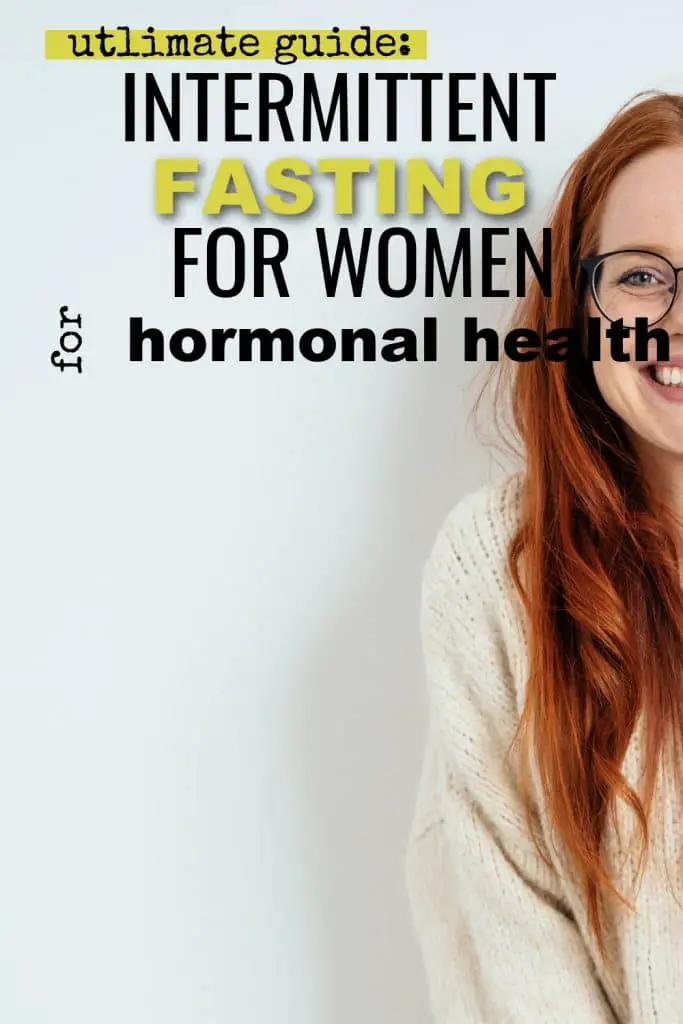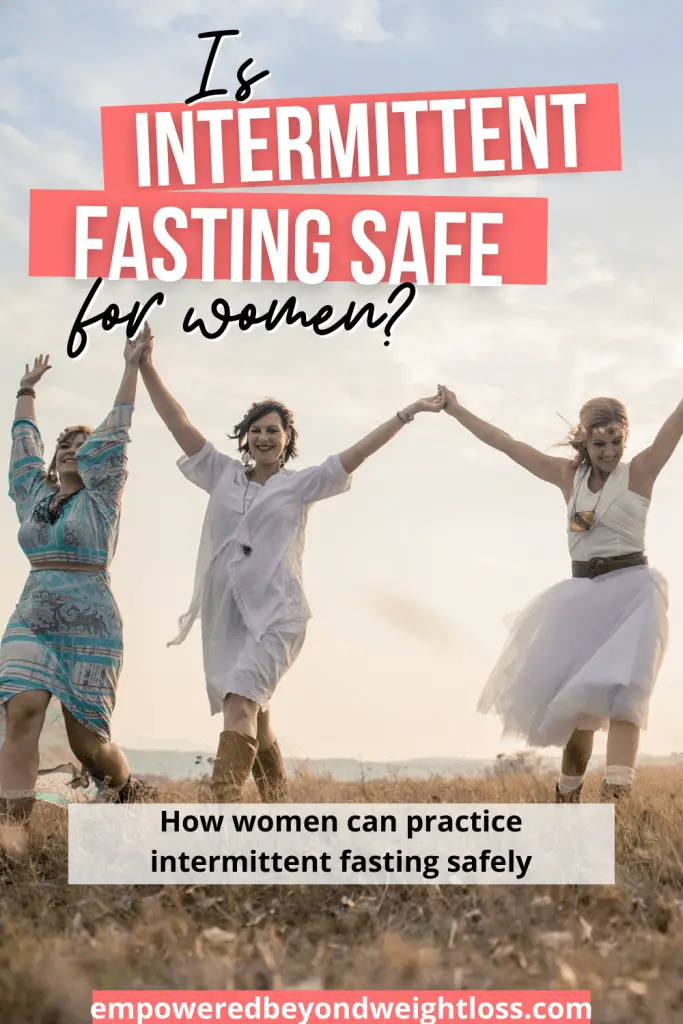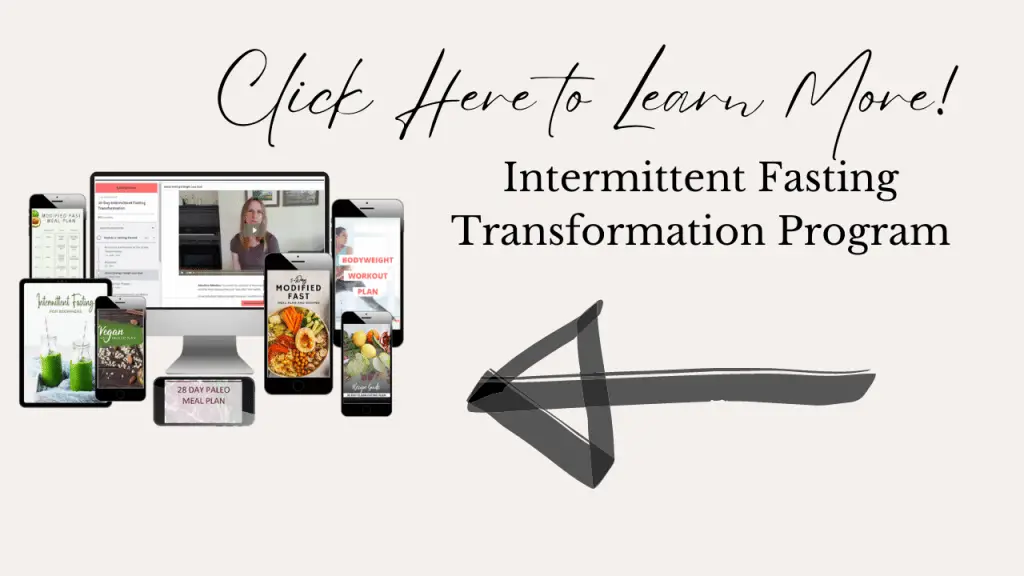Intermittent fasting for women does require some precautions to be done safely. The protocol must follow simple guidelines to avoid stressing a woman’s body too much and causing hormonal issues.
For a long time, I thought intermittent fasting meant skipping breakfast every day. I “tried” and didn’t like it, so I decided it was not for me. Moreover, I read that intermittent fasting can adversely affect women’s hormonal health. I figured women should avoid it as a general rule. However, that isn’t true. Let me share how women can practice intermittent fasting safely.
Types of Intermittent Fasting
There are many different ways to do intermittent fasting. That’s what makes it so great. When I was convinced that intermittent fasting could be harmful to me as a woman, I was thinking about daily intermittent fasting. I didn’t realize that there are many different types of intermittent fasting:
- 16/8 Daily fasting: Probably the most common and well-known type of fasting. You fast for 16 hours and eat your meals within 8 hours.
- 20/4 Daily fasting: In this case, you cut your eating window in half. There are many other different variations of daily fasting, and some people even eat all their food within an hour timeframe. However, 16/8 and 20/4 are the two daily fasting choices most often referred to.
- 5:2 Diet: Eat normally for days while restricting your calorie intake to 500-600 calories for the remaining two days.
- Eat-Stop-Eat: This type of intermittent fasting requires you to fast for 24 hours each week. You could start after dinner one day and eat dinner the following evening after your 24 hours are up.
Intermittent fasting for women requires picking the right method. Of course, this “right” method will vary amount women, but overall a longer but less frequent fasting window is optimal. This will mean not fasting every day.

The Fasting Mimicking Diet
The fasting-mimicking diet is not intermittent fasting per se. However, like intermittent fasting, it takes advantage of the healing benefits of short-term deprivation. I mention it here because it is an excellent tool to kickstart your intermittent fasting journey. As you will read, cycling is an integral part of intermittent fasting for women. The fasting-mimicking and keto diets may be included in your cycles, and you will see how. The purpose of the fasting-mimicking diet is slight starvation for four to five days. Prolonged fasts have been shown to allow for greater benefits as far as cell regeneration goes. However, prolonged water fasting can have negative effects, and that’s where the fasting-mimicking diet comes in.
Differences Between the Fasting Mimicking Diet and Intermittent Fasting
In the context of intermittent fasting for women, fasting-mimicking can play an important role. Understanding the difference between intermittent fasting and fasting mimicking will enable you to correctly use both tools to reach your health and weight loss goals.
There are two main differences:
- The fasting-mimicking diet (FMD) does not only define your eating-fasting cycle. It also specifies the types of foods and the macronutrient ratios you need to be consuming. My post The Fasting Mimicking Diet: Benefit From Fasting Without Giving Up Food explains it all.
- The FMD is a prolonged fast. Intermittent fasting is always for less than 48 hours.

Why Intermittent Fasting Works
Intermittent fasting for women is safe. Not only is it safe, but it offers many benefits. A significant advantage of intermittent fasting is that you accommodate it to suit your lifestyle and your needs. You can even eat the foods you want, contrary to many “diets” that require you to follow a specific plan.
Benefits of Intermittent Fasting for Women
Intermittent fasting, like fasting-mimicking, reproduces many benefits of fasting without undergoing extended water fasting. The feast-starve cycle can bring much healing. Unfortunately, this natural eating cycle is surrounded by too much drama and fear. Here are just some of the benefits:
- Improves insulin sensitivity: A better insulin sensitivity means better health. Insulin is one of the mother hormones in your body at the root of inflammation and metabolic diseases.
- Weight loss: During the fasting duration of 18 to 24 hours, cell shift from burning glucose to burning fat. This benefit is more pronounced after 18 hours.
- Decreased cholesterol levels: Small dense LDL particles are associated with an increased risk for cardiovascular disease. Intermittent fasting reduces these particles by 25% after eight weeks.
- Decreased inflammation: Intermittent fasting reduces some inflammation markers.
- Improved cognitive function: Intermittent fasting reduces DNA damage in specific regions of the brain.

Is Intermittent Fasting Safe for Women?
Intermittent fasting is safe for women, but some considerations should be taken into account:
- Because of the significance of their reproductive abilities, women have a high sensitivity to starvation. When they go without food, starvation signals are sent to the brain, and their body will ramp up the production of hunger hormones (leptin and ghrelin).
- When the production of leptin and ghrelin increases, it can cause hormonal imbalances.
- Women who are pregnant or breastfeeding should avoid long-term sustained intermittent fasting.
- Underweight women should avoid intermittent fasting.
- Women who have a history of fertility problems should avoid fasting as well.

Intermittent Fasting and Women’s Hormonal Health
Intermittent fasting for women must be done to protect hormonal function. The good news is that it may optimize insulin sensitivity, which has a domino effect on your other hormones.
Adrenal Function
Cortisol is your body’s main stress hormone released by your adrenal glands. If your cortisol levels are always high or low, your brain is not communicating properly with your adrenals.
Here are some symptoms you might experience:
- Trouble getting started in the morning
- Craving salty or sugary foods
- Low sex drive
- Fatigued in the afternoon, but you get a “second wind” in the evening
- Trouble staying asleep at night
- Dizziness after standing up too quickly
- Afternoon headaches
- Blood sugar issues
- Chronic inflammation
- Weak nails and brittle hair
- Moodiness
- Trouble losing weight
For some women, the stress of fasting is too much for the adrenals, so they feel worse than before. Women with adrenal dysfunction should be careful when experimenting with intermittent fasting. Crescendo fasting would be a good place to start (see below for your crescendo intermittent fasting meal plan).

Thyroid Function
Your thyroid affects every cell in your body because every cell in your body needs thyroid hormone to produce energy. Many thyroid problems won’t show in standard lab work because they stem not from the lack of thyroid hormone but from the body’s ineffectiveness in converting thyroid hormone.
Thyroid dysfunction may cause the following symptoms:
- Feeling tired
- Cold feet, hands, or cold all over
- Requiring extra sleep to function properly
- Rapid weight gain
- Constipation
- Depressed or lack of motivation
- Morning headaches that subside as the day goes on
- Thinning of the outer third of eyebrows
- Excessive hair loss or thinning
- Dry skin
- Brain fog
The stress of fasting impacts your metabolism and how your body uses energy. It increases cortisol levels and causes a drop in the thyroid hormone T3. Since intermittent fasting helps reduce inflammation, it improves diseases like multiple sclerosis and rheumatoid arthritis. It may help improve other autoimmune conditions, but more research is needed. Once again, starting slowly and monitoring your body’s reaction is key. Make sure you are not eating inflammatory foods when you are not fasting. Intermittent fasting for women is all about avoiding too much stress on your body and nourishing your body well during your eating window.

How To Practice Intermittent Fasting Safely for Women
Generally, intermittent fasting for women boils down to phasing. That’s partly what I meant when I said intermittent fasting for women was about avoiding too much stress on your body. Whatever method you choose as a woman, you must ensure you are not practicing it sustainably. This way, you reap the benefits of intermittent fasting while allowing your body to resume its normal function regularly. Many recommend women start the crescendo intermittent fasting method.
Intermittent Fasting Schedule for Women
The key to fasting safely for women is to use an intermittent fasting method that you can phase in and out of. When you pick your fasting schedule, pick one that doesn’t require fasting daily. Instead, you may want to fast every other day (as in the Crescendo method) or one to three days a week, like the Eat-Stop-Eat Method or the 5:2 Method.
- Eat-Stop-Eat (or the 24-hour protocol): You can start with a 16-hour fast and build gradually. The idea is to fast 2-3 times a week.
- 5:2 Diet: Restrict your calories to 20-25% of your regular intake two consecutive days a week.
What is the Crescendo Method?
The crescendo method means you are not fasting every day of the week. For example, you could fast for 18 hours, three nonconsecutive days a week (like Monday, Wednesday, and Friday).
Crescendo Intermittent Fasting 7-Day Meal Plan
This meal plan is a good starting point to practice the crescendo method to phase out your fasting.

Do you like intermittent fasting meal plans? Check out My 7-Day Intermittent Fasting for Weight Loss Meal Plan.
Cycling
Cycling in and out of your chosen intermittent fasting method and diet style is helpful to en sure you avoid stressing your body too much. For example, if your chosen intermittent fasting window is the 20/4, fast no more than 5 days a week. Moreover, ease up your window during the last week of your cycle (as we will discuss in the next section). If you enjoy eating low-carb or keto, ramp up the carbs occasionally. Or if you never restrict carbs, go on a 7-10 day keto cycle once in a while. Consider all the tools available to you and determine which ones are best suited to your needs at any given time.
Fasting According to Your Cycle
Another key consideration in the context of intermittent fasting for women is your cycle. Contrary to men, women have monthly cycles, and this cycle should be honored. Women frequently feel hungrier and want more carbs during the last week or two of their menstrual cycle. Keep that in mind as you phase out cycling and carb restrictions. Plan in a way that enables you to take advantage of the beginning of your cycle to fast more strictly while easing out restrictions at the end of the month
Other Ways To Intermittent Practice Fasting for Women
Intermittent fasting benefits women, but longer fasts are preferable for the best results. As I mentioned, many fasting benefits increase as you increase the duration of the fast. For example, it takes 18 hours before the body starts to switch to burning fat rather than glucose. Many cell regeneration benefits begin after a 3-day fast. For example, fasting for up to 5 days may protect patients from the effects of chemotherapy. If you want to get the most fasting benefits without impacting your hormonal function negatively, there are a few more options available to you:
- Fasting mimicking: My favorite method, even though it’s not quite the same as intermittent fasting, as I said. I prefer it because it allows you to extend your fast’s duration for maximum benefits safely. If you are a woman over 40, you will enjoy this post about Fasting for Women Over 40.
- Modified alternate-day fasting: If you use this method, you fast every other day but are allowed to consume 20-25% of your normal caloric intake on fasting days.

Individual Differences Among Women
Intermittent fasting for women doesn’t follow a set of rules that work for everyone. Body shape and composition are a predictor of different biochemical markers among women. The point is: Intermittent fasting will impact different women differently. Each person is unique; this fact doesn’t stop at gender differences. You are the owner of your body. For this reason, you need to experiment to see what works for you.
Warning Signs You Should Stop Intermittent Fasting
If you notice any of the following signs, I recommend you take a step back:
- Hair loss
- Low energy
- Mood swings
- Muscle pain
- Low libido
- Changes in your menstrual cycles

In Summary
The beauty of intermittent fasting is that you can choose and experiment with how long you fast. You can make it work for YOU. Regarding intermittent fasting for women, the key is to respect your body. Listen to what it is saying. Don’t embark on this journey because you hate your body. Instead, do it out of love.
If like me, you thought intermittent fasting wasn’t a good idea for women, I hope I have shown you that it isn’t true. Intermittent fasting can be adapted in many ways; it can work for women. It enabled me to experience true food freedom and lose 30 pounds after 40. That’s why I created my Weight Loss Transformation Program, a multimedia program that includes all the resources needed to achieve your weight loss goal by biohacking with intermittent fasting.






